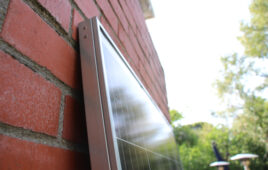Coming on the heels of President Joe Biden’s stated desire to produce more solar components stateside, U.S. Congressman Tim Ryan (D-OH) today introduced the Ensuring America Gets Legitimate Energy Sourced, Originating, and Leased at Home Reliably (EAGLE SOLAR) Act to the U.S. House of Representatives. The new legislation would close a loophole in the Buy American Act that would require American-made solar products be used in federally orchestrated solar PPAs.
Currently, the federal government does not buy solar equipment directly, instead only purchasing energy via PPAs from American companies. Those companies are not required to use American-made solar panels or other equipment to generate that energy. The EAGLE SOLAR Act would close that loophole and require the American developers and solar system owners to use American equipment in order to fulfill federal PPAs.
Original cosponsors of the Act include Marcy Kaptur (D-OH) and Peter DeFazio (D-OR).
“American workers and American companies must be the ones who power America. The EAGLE SOLAR Act will cement Ohio’s role as a hub of solar innovation and support living wage jobs for hardworking men and women throughout the industry,” said Congresswoman Kaptur.

NREL illustration showing the stages of creating crystalline silicon solar panels. The only thing able to be accomplished within the borders of the United States right now is assembling foreign solar cells into final solar panels.
Many select quotes from Congressmembers and local businesses repeatedly state that this Act would stop the United States from depending on Chinese solar panels, which is already something the country does not do. Very few imported solar panels come from China, with most imported crystalline silicon solar panels coming from Southeast Asia. There is no further information on what exactly this Act would demand — what constitutes an American solar panel? With no solar cell manufacturers in the United States, some portion of the solar panel will undoubtedly be made in Asia. Currently, the United States only hosts domestic solar panel assemblers, not full-scale manufacturers.
It should be noted that Congressman Ryan represents Ohio, home to the world’s largest thin-film solar panel manufacturer First Solar, a company that is largely supportive of additional tariffs on solar panels coming from Southeast Asia. First Solar uses cadmium telluride in its solar panels, not crystalline silicon, which is the solar panel makeup that is under investigation right now by the Dept. of Commerce and what makes up the large majority of global solar panel sales. First Solar panels are already inherently “American made” and eligible for the Buy American Act requirements under this new proposal. If U.S. crystalline silicon solar panel assemblers have to import solar cells from outside the country (which is already impossible to avoid), their solar panels would not be eligible to be used in projects under federal PPAs.





It’s a good effort to bolster American solar manufacturing, though it will be challenging in practices. We use American-made solar panels and would love to source more of our supplies in the USA, but the globalized supply chain will make that challenging moving forward.
That’s the ‘rub’ isn’t it. Most all of the solar PV panel (manufacturers) in the U.S. right now has a firmly attached Chinese supply chain for silicon wafers, solar PV cells probably right down to the glass and aluminum frames that make up the panels.
Apparently Ryan is a cheerleader for First Solar, he has cut out many of the manufacturing facilities doing business in the U.S. right now which leaves, (First Solar).
First Solar may or may not get their refined materials of Cd and Te from China, but there is no silicon foundry used in the First Solar thin film solar PV panels, First Solar has had a cradle to cradle recycling program in place since 2003 and it just so happens that First Solar is focused on utility scale solar PV farms that use 27 to 32 square foot panels, designed to put out around 225VDC per panel. First Solar has announced that all the panel manufacturing lines (will) be powered with solar PV by 2028. The early push for utility scale solar PV in the desert region in Riverside county, the McCoy solar PV farm is using First Solar series four or five solar PV panels and is rated at 250MWac peak. McCoy has enough real estate available for three more phases and a build out of 1GWpdc on average 6GWh to 10GWh generation a day.